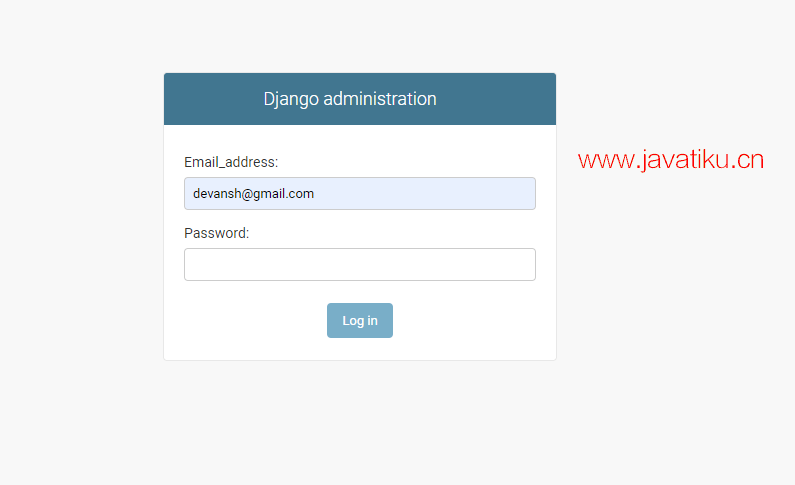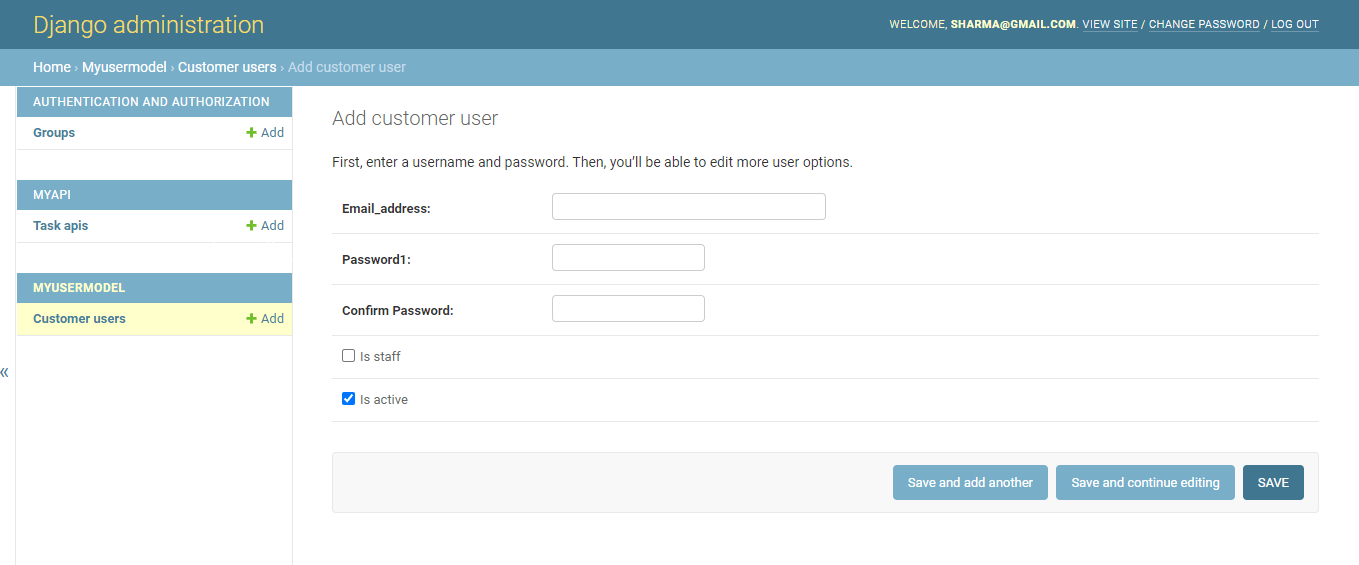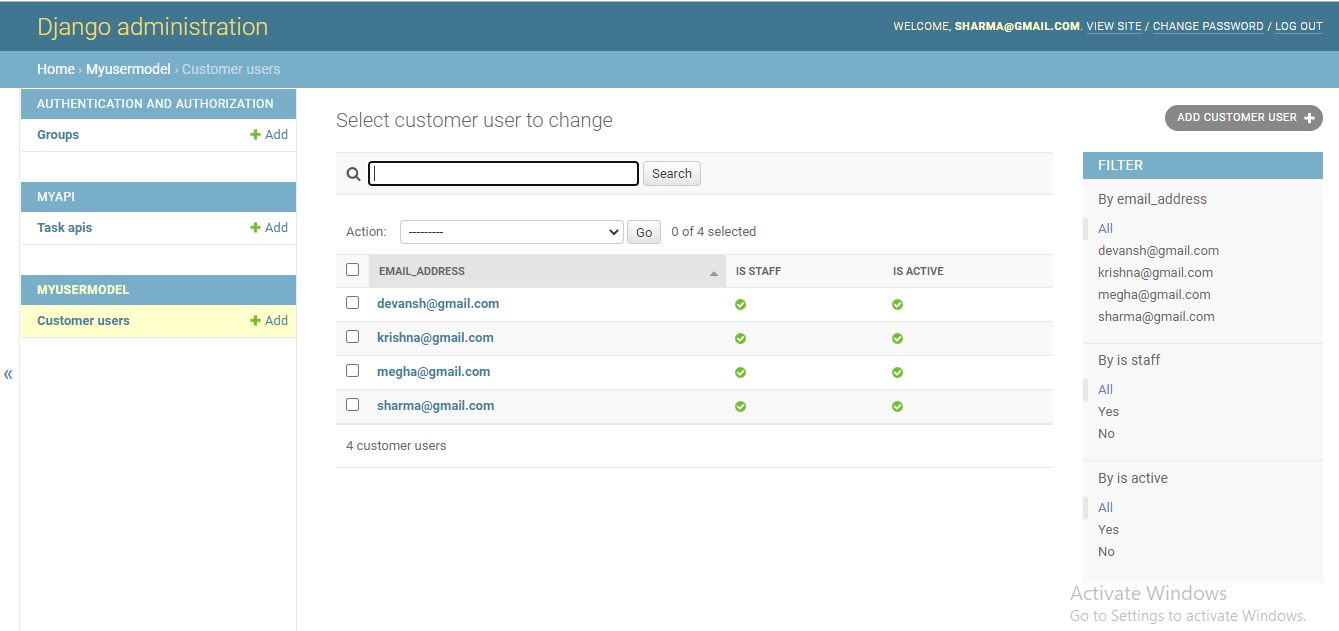Diango教程-Django 自定义用户模型

Django 具有出色的内置用户模型和身份验证支持。这是大多数开发人员更喜欢 Django 而不是 Flask、FastAPI、AIOHttp 和许多其他框架的主要原因。
但有时我们对用户模型不满意,或者我们想根据项目需求进行定制。假设我们不再需要用户名字段。或者我们想使用用户的电子邮件而不是默认的用户名。为此,我们需要自定义默认的Django 用户模型。
在本教程中,我们将从头开始构建用户模型。您应该记住的一件事是自定义 Django 默认值会增加复杂系统的复杂性。因此,请尝试坚持使用默认的用户模型。但针对项目需求,我们可以进行默认的更改。
我们将使用 Django 内置AbastractBaseClass,它通过自定义类名继承。
先决条件
- 安装最新的 Django (2.2 +)
- 创建 Django 项目
- 进行基本配置
- 创建虚拟环境
在 Django 中创建自定义用户模型
我们的第一步是使用以下命令在项目中创建一个应用程序。
python manage.py startapp MyUserModel该应用程序将在项目目录中创建。现在将应用程序注册到 settings.py 文件。
我的用户模型/setting.py
INSTALLED_APP = [
?????
?????.
MyUserModel
] 2. 为自定义用户创建模型
现在我们将在 models.py 文件中创建自定义用户模型。我们看下面的代码。
from django.db import models
from django.contrib.auth.models import AbstractBaseUser, PermissionsMixin
from django.utils import timezone
from django.utils.translation import gettext_lazy as _
from .managers import CustomUserManager
# Create your models here.
class CustomUser(AbstractBaseUser, PermissionsMixin):
username = None
email = models.EmailField(_('email_address'), unique=True, max_length = 200)
date_joined = models.DateTimeField(default=timezone.now)
is_staff = models.BooleanField(default=False)
is_active = models.BooleanField(default=True)
USERNAME_FIELD = 'email'
REQUIRED_FIELDS = []
objects = CustomUserManager()
def has_perm(self, perm, obj=None):
"Does the user have a specific permission?"
# Simplest possible answer: Yes, always
return True
def is_staff(self):
"Is the user a member of staff?"
return self.staff
@property
def is_admin(self):
"Is the user a admin member?"
return self.admin
def __str__(self):
return self.email 我们来理解一下上面的模型;我们创建了一个名为CustomUser的类,它继承了 AbstractbaseClass。然后,我们添加了电子邮件、is_staff、 is_active和date_joined字段。
- 用户名设置为 none,因为我们希望通过唯一的电子邮件 ID 而不是用户名来验证用户身份。
- 如果用户允许登录管理面板,则is_staff返回true。
- 如果用户当前处于活动状态,则is_active返回true。如果用户不活跃,他/她将不允许登录。
- USERNAME_FIELDS定义用户模型的唯一标识 - 电子邮件。
- 当我们通过createsuperuser命令创建超级用户时,REQUIRED_FIELDS会提示字段。它必须包含空白为 False 的任何字段。
- 管理器类对象指定该类的所有对象都来自 CustomeUserManager 。如果用户拥有每个指定的权限,则has_permission返回true。
3. 创建模型管理器
Django 为用户管理器提供了内置方法。但如果我们要创建自定义用户模型,则需要重写默认方法。创建一个新文件管理器.py(可以有所不同)并创建用户模型管理器。以下方法由 BaseUserManager 提供。
from django.contrib.auth.base_user import BaseUserManager
from django.utils.translation import ugettext_lazy as _
"""
Custom user model manager where email is the unique identifiers
for authentication instead of usernames.
"""
class CustomUserManager(BaseUserManager):
"""
Custom user model manager where email is the unique identifiers
for authentication instead of usernames.
"""
def create_user(self, email, password, **extra_fields):
"""
Create and save a User with the given email and password.
"""
if not email:
raise ValueError(_('The Email must be set'))
email = self.normalize_email(email)
user = self.model(email=email, **extra_fields)
user.set_password(password)
user.save()
return user
def create_superuser(self, email, password, **extra_fields):
"""
Create and save a SuperUser with the given email and password.
"""
extra_fields.setdefault('is_staff', True)
extra_fields.setdefault('is_superuser', True)
extra_fields.setdefault('is_active', True)
if extra_fields.get('is_staff') is not True:
raise ValueError(_('Superuser must have is_staff=True.'))
if extra_fields.get('is_superuser') is not True:
raise ValueError(_('Superuser must have is_superuser=True.'))
return self.create_user(email, password, **extra_fields)
def get_full_name(self):
'''
Returns the first_name plus the last_name, with a space in between.
'''
full_name = '%s %s' % (self.first_name, self.last_name)
return full_name.strip()
def get_short_name(self):
'''
Returns the short name for the user.
'''
return self.first_name 我们创建了继承 BaseUserManager 的CustomManagerClass 。它提供了以下辅助方法。
- create_user ()方法创建、保存并返回用户。它会自动将电子邮件转换为小写,并且返回的 User 对象会将 is_active 设置为 true。
- create_superuser ()方法将is_staff和is_active设置为 True。
- get_full_name ()返回用户的全名。
- get_short_name返回用户的名字。
4. 将自定义用户注册到setting.py
需要将创建的自定义用户模型注册到setting.py文件中,否则Django会将其视为自定义用户模型。它将通过一个错误。打开setting.py 文件并注册您的自定义用户模型。
AUTH_USER_MODEL = appName.ClassName 在我们的例子中,它将是 -
AUTH _USER_MODEL = MyUserModel.CustomUser 现在我们可以创建并应用 make 迁移,这将创建使用自定义用户模型的新数据库。让我们运行以下命令。
python manage.py makemigrations
python manage.py migrate 我们将得到如下的迁移文件。
# Generated by Django 3.2.6 on 2021-08-09 19:55
from django.db import migrations, models
import django.utils.timezone
class Migration(migrations.Migration):
initial = True
dependencies = [
('auth', '0012_alter_user_first_name_max_length'),
]
operations = [
migrations.CreateModel(
name='CustomerUser',
fields=[
('id', models.BigAutoField(auto_created=True, primary_key=True, serialize=False, verbose_name='ID')),
('password', models.CharField(max_length=128, verbose_name='password')),
('last_login', models.DateTimeField(blank=True, null=True, verbose_name='last login')),
('is_superuser', models.BooleanField(default=False, help_text='Designates that this user has all permissions without explicitly assigning them.', verbose_name='superuser status')),
('email', models.EmailField(max_length=254, unique=True, verbose_name='email_address')),
('is_staff', models.BooleanField(default=False)),
('is_active', models.BooleanField(default=True)),
('groups', models.ManyToManyField(blank=True, help_text='The groups this user belongs to. A user will get all permissions granted to each of their groups.', related_name='user_set', related_query_name='user', to='auth.Group', verbose_name='groups')),
('user_permissions', models.ManyToManyField(blank=True, help_text='Specific permissions for this user.', related_name='user_set', related_query_name='user', to='auth.Permission', verbose_name='user permissions')),
],
options={
'abstract': False,
},
),
] 正如我们所看到的,没有用户名字段,因为它在创建自定义用户模型时被删除了。
5. 创建超级用户
运行以下命令来创建超级用户。
python manage.py createsuperuser上面的命令将提示电子邮件和密码字段以创建超级用户。
Email address: test@test.com
Password:
Password (again):
Superuser created successfully.创建表单来存储用户信息
我们将使用默认子类UserCreationForm表单创建表单,以便可以使用自定义用户模型。
让我们在“MyUserModel”中创建一个 forms.py 文件。
forms.py
from django.contrib.auth.forms import UserCreationForm, UserChangeForm
from django.db.models import fields
from django import forms
from .models import CustomerUser
from django.contrib.auth import get_user_model
User = get_user_model()
class CustomUserCreationForm(UserCreationForm):
password1 = forms.CharField(widget=forms.PasswordInput)
password2 = forms.CharField(label='Confirm Password', widget=forms.PasswordInput)
class Meta:
model = CustomerUser
fields = ('email', )
def clean_email(self):
email = self.cleaned_data.get('email')
qs = User.objects.filter(email=email)
if qs.exists():
raise forms.ValidationError("Email is taken")
return email
def clean(self):
'''
Verify both passwords match.
'''
cleaned_data = super().clean()
password1 = cleaned_data.get("password1")
password2 = cleaned_data.get("password2")
if password1 is not None and password1 != password2:
self.add_error("password2", "Your passwords must match")
return cleaned_data
def save(self, commit=True):
# Save the provided password in hashed format
user = super().save(commit=False)
user.set_password(self.cleaned_data["password1"])
if commit:
user.save()
return user
class CustomUserChangeForm(UserChangeForm):
class Meta:
model = CustomerUser
fields = ('email', )
def clean_password(self):
# Regardless of what the user provides, return the initial value.
# This is done here, rather than on the field, because the
# field does not have access to the initial value
return self.initial["password1"] CustomUserCreationForm类继承了UsecreationForm ,它由三个字段组成:用户名、密码1和密码 2。密码 1 与密码 2 匹配,如果两个密码都匹配,则 validate_password() 验证密码并使用set_password() 设置用户的密码。密码将以散列格式保存。
现在我们将自定义管理面板。
自定义管理面板
默认的管理面板非常有用,可以有效地排列信息,但我们可以通过提供所需的信息来实现它。让我们看一下管理面板的以下代码。
admin.py
from django.contrib import admin
from django.contrib.auth import authenticate
from django.contrib.auth.admin import UserAdmin
# Register your models here.
class CustomUserAdmin(UserAdmin):
add_form = CustomUserCreationForm
form = CustomUserChangeForm
model = CustomerUser
list_display = ('email', 'is_staff', 'is_active',)
list_filter = ('email', 'is_staff', 'is_active',)
fieldsets = (
(None, {'fields': ('email', 'password')}),
('Permissions', {'fields': ('is_staff', 'is_active')}),
)
add_fieldsets = (
(None, {
'classes': ('wide',),
'fields': ('email', 'password1', 'password2', 'is_staff', 'is_active')}
),
)
search_fields = ('email',)
ordering = ('email',)
filter_horizontal = ()
admin.site.register(CustomerUser, CustomUserAdmin) 现在我们准备创建新用户。运行以下命令并使用超级用户凭据登录管理面板。

一旦我们登录到管理面板。我们看到“添加自定义用户”按钮,在其中创建新用户。

创建一些用户后,管理面板将如下所示。

结论
Django 因其内置功能而广受欢迎,这节省了开发人员的大量时间。但有时我们需要的功能在内置模型中是不可用的。但是,我们可以用自己的方式创建它们。在本教程中,我们通过扩展 AbstractBaseClass 创建了自定义用户模型。我们创建了管理器类来管理用户对象。您可以借助本教程创建新的自定义用户模型。您可以为用户提供更多的权限,并可以制作功能齐全的用户模型。



